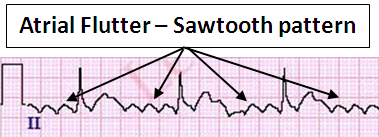ECG Reviews
Atrial Flutter ECG Review
Atrial flutter occurs when a “reentrant” circuit is present, causing a repeated loop of electrical activity to depolarize the atrium at a rate of about 250 to 350 beats per minute; the atrial rate in atrial fibrillation is 400 to 600 bpm.
This produces a characteristic “sawtooth” pattern of the P waves — different from atrial fibrillation, in which the atrial rate is so fast that the P waves are not identifiable, or only coarse fibrillatory waves are seen.
Just as in atrial fibrillation, not all of the P waves are able to conduct through the atrioventricular node, and thus the ventricular rate will not be as fast as the atrial rate. Typically, the atrial rate will be about 300 bpm, and only every other atrial depolarization will be conducted through the AV node. In this situation, the ventricular (QRS) rate will be exactly 150 bpm and regular.
CLINICAL PEARL: A narrow complex tachycardia at a ventricular rate of exactly 150 bpm is very commonly atrial flutter.
The regularity of the QRS complexes frequently present with atrial flutter helps to distinguish it from atrial fibrillation, though atrial flutter with variable conduction of the P waves can also occur. In this situation, there may be three P waves to one QRS complex, then a quick change to two P waves to one QRS complex, and so on; any combination of P waves to QRS complexes can occur. This results in the rhythm becoming “irregularly irregular.” There are only two other rhythms that are commonly irregularly irregular, including atrial fibrillation and multifocal atrial tachycardia, or MAT.
When the heart rate is significantly elevated — that is, greater than 150 bpm — it is often difficult to determine atrial flutter from atrial fibrillation, atrial tachycardia or atrioventricular nodal reentrant tachycardia, or AVNRT. In this situation, giving adenosine will transiently slow the ventricular rate, unmasking the atrial flutter waves and allowing a more definitive diagnosis to be made.
Atrial flutter can described as “typical” (type I) or “atypical” (type II) based on the anatomic location from which it originates. Also, atrial flutter can be described as “clockwise” or “counterclockwise” depending on the direction of the circuit.
Typical atrial flutter rotates counterclockwise in direction, from a reentrant circuit around the tricuspid valve annulus and through the cavo-tricuspid isthmus. This results in negatively-directed flutter waves in the inferior leads.
At times, the direction of the circuit can reverse, causing clockwise atrial flutter from the same anatomical location. This appears as positively-directed flutter waves in the inferior leads. Atypical atrial flutter originates from the left atrium or areas in the right atrium, such as surgical scars, and has a variable appearance on ECG in regards to the flutter waves.
ECG Examples:
- Atrial Flutter with 1:1 Conduction ECG
- Atrial Flutter with 2:1 Conduction ECG (Example 1)
- Atrial Flutter with 2:1 Conduction ECG (Example 2)
- Atrial Flutter with 3:1 Conduction ECG
- Atrial Flutter with 4:1 Conduction ECG (Example 1)
- Atrial Flutter with 4:1 Conduction ECG (Example 2)
- Atrial Flutter with 4:1 Conduction ECG (Example 3)
- Atrial Flutter with 5:1 Conduction ECG (Example 1)
- Atrial Flutter with 5:1 Conduction ECG (Example 2)
- Atrial Flutter with Variable Conduction ECG (Example 1)
- Atrial Flutter with Variable Conduction ECG (Example 2)
- Atrial Flutter with Variable Conduction ECG (Example 3)
References:
1. Chou’s Electrocardiography in Clinical Practice: Adult and Pediatric, 6e
2. Surawicz B, et al. AHA/ACCF/HRS Recommendations for the Standardization and Interpretation of the Electrocardiogram. Circulation. 2009; doi:10.1161/CIRCULATIONAHA.108.191095.



